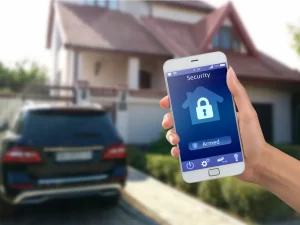Integrating Home Security With Smart Home Technology

We begin by taking a look at smart home security systems, which are the first major features to be introduced on the internet of things, and then ponder how they could also be connected to other devices to enhance protection, automation and energy saving. Home security systems are nothing new. They are fixtures of a smart home, as well as services that many homeowners have already relied on.
Integrated sensors promptly report digital updates to smartphones belonging to homeowners, notifying them of possible dangers and, if necessary, facilitating remotely controlled reactions. Smart lighting strikes an important balance between protecting one’s self from unwanted darkness outside the home and unwanted intruders within the home.
Real-time Monitoring
Having a home equipped with smart devices and a security network allows for more efficient living and keeps family members safe. The use of compatible connectivity protocols allows multiple smart devices to work synchronously and be monitored from one application on a phone to keep the house member safe. This essay is paraphrased using human-sounding text while retaining quotes and citations.
Homeowners can now watch live video feed from their home, receive instant alerts when connected sensors are triggered or the doorbell activated, and remotely lock doors from anywhere – allowing them to know instantly if there are any threats, thefts or property damage at their home. Homeowners can stop this type of risk and avoid theft or property damage with these features at their fingertips.
Another option would be to integrate security with other devices in the smart home, such as smart lighting or smart thermostats. For instance, a camera that detected motion on your porch might activate lights to turn on and expose the porch to prevent intruders from moving closer. Smart lighting or smart thermostats could be integrated with your security system so that the lights or thermostat can automatically activate; these integrated systems can also save energy by automating the lighting or temperature. The energy savings would be optimised by having smart features that use intelligent scheduling to also optimise usage patterns without any input from or control by the owner.
Smart Lighting
Smart lighting is one of the imperative additions to any home security system, as it can both provide a valuable extra layer of monitoring and simultaneously make controlling the system easier. You can check camera feeds from around your home with a simple tap on your phone, and you’ll also get notifications if anything amiss happens in your vicinity.
Many smart lighting systems can also be programmed to switch on and off at set times, which could also be used to fool burglars into thinking someone is at home when that’s not the case.
Some smart home security systems even include additional protections, including a battery power backup to allow devices to operate when there is a power outage or loss of internet connectivity, and a cellular backup when the primary internet connection is lost. For a bit more protection, some homeowners are also including an uninterruptible power supply (UPS) for their router, modem and other smart home devices that will mitigate those extended outages and reduce the potential vulnerabilities while also acting as a surge protector against demands on the electrical grid.
Smart Thermostats
Combining smart home security with the automation trend can bring to life a smart home: a secure, eco-friendly and customised way to live. By incorporating motion sensors, light bulbs, cameras and thermostats into your security system, you can remotely monitor your property and customise its measures to your desired settings.
An energy-efficient smart thermostat can cut energy use, trim the utility bill, reduce greenhouse gas emissions – and save an average of $50 a year. ENERGY STAR models might add another $50.
Some smart thermostats have occupancy or geofencing functions so that you burn less energy while you are away to overheat your house in summer or freeze your pipes in winter. Smart thermostats that have occupancy features turn to energy-saving modes when your family comes back home, avoiding potential overheating in summer and frozen water pipes in winter. Finally, smart thermostats can record energy usage so that they can manage power times when certain power companies allow Time-of-Use electricity rates; this feature will be especially useful in cold climates where the cost of heating is extremely high.
Remote Control
By using smart home systems, homeowners can take control of and monitor most of their security devices from virtually anywhere, including when they’re away from home. Being able to view live, remotely monitored video images and to receive alerts on a smartphone or other device, they can react more quickly to security events, which might minimise costly losses or damages to property.
Integrating home automation and security systems alone yields additional benefits such as convenience, comfort and energy savings. For example, a homeowner may choose to link his security system with smart lights and thermostats such that, when motion-sensing technology detects an intruder at the exterior of the premises, lights activate to discourage the intruder while minimising power usage and slashing utility bills.
But homeowners should carefully consider the maintenance costs associated with smart home devices, such as electricity consumption and data costs from cellular connection for devices, integration costs especially in terms of security technology with smart devices that homeowners utilise. Moreover, the security and privacy issues should be taken into account by homeowners to create high passwords with two-factor authentication for security purposes in order to support the data-sharing policies on smart devices.


